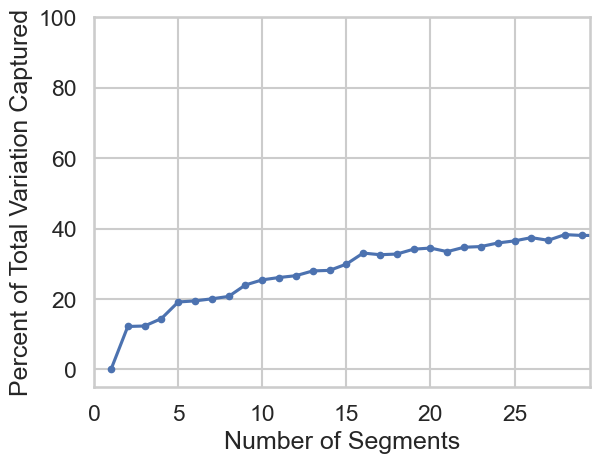
Greg Novak
Are you using enough customer segments? Almost certainly not, unless you're using VarietyIQ!
Merchandising teams sometimes attempt to split their customer base into segments, and then work to ensure each is well supported with products they love. The idea is to lift sales, although this also increases work for the merchandising team.
We've seen this approach fail time and again. Why? As we show here you need an unmanageably large number of customer segments to capture even a small fraction of the variation in preferences of a customer base. This sets up an unfavorable tradeoff between benefit captured and work needed. Is the benefit of segmentation for merchandising illusory then? No, not if you use VarietyIQ!
The first job of any business is to find product-market fit with a single customer profile. In these initial stages of growth, finding and catering to a "core customer" is more important than worrying about variations of taste or preferences within the customer base.
There soon comes a day, however, when new customer acquisition becomes more difficult and growth slows---word has spread and most of the "core customers" who resonate most with your brand have already heard of it.
To keep growth going, it's time to expand your brand's appeal, and the a common way of doing that is to start defining different segments within your customer base and catering to each segment. These may be behavioral (e.g. busy shoppers who value convenience), demographic (e.g. younger customers) or stylistic (e.g. customers who prefer brighter colors).
The problem is that this is a work driver for the merchandising and planning teams: each additional customer segment requires budgeting, oversight and roll-ups. Defining just four customer segments may quadruple the amount of work for the buying and planning teams. Do you plan to quadruple your head count?
And then there's overlap between what each customer segment wants to buy: Product A might appeal to only one customer segment, while product B appeals to three different ones. How do you make sure everything adds up while at the same time all customers are well-served?
As you cater to more segments, the expectation is for revenue to go up (with diminishing returns at some point) while the cost in terms of labor also goes up. This is a classic optimization problem: we expect the benefit minus the cost to reach a maximum at some number of segments, and that's the number of customer segments that you should consider.
We can find the answer using real consumer data from our customer Taylor Stitch, a Men's apparel retailer. We've used their customer purchase data to fit a personalization model giving product-customer affinity scores for every customer and product in Taylor Stitch's offering.
How much of that variation remains if we use k-means clustering to define customer segments and then replace the preferences of each customer with the preferences of the "persona" of the segment to which they belong? Here is the answer:

The number of customer segments is shown on the x-axis and the percent of variation that remains after the segmentation is on the y axis. So with one segment, we've caputured zero percent of the variance, while with five segments, around 20 percent of the full population variance remains.
That's to say that you've lost visibility into eighty percent of the variation in personalized tastes and preferences of your customer base, and meanwhile you've quintupled the amount of work the buying, planning, and merchandising teams have to do!
Human-managed customer segments are almost certainly not worth the cost for any number of segments: Defining only two segments doubles the necessary work but only gives visibility into about 15 percent of the total variation in preferences that exists in your customer base. Meanwhile even going up to 30 segments---an unimaginable amount of work, and probably impossible for humans to keep a taxonomy of 30 "personas" straight---still doesn't even capture the majority of the total variation in preferences.
Is this where the story ends? Is customer segmentation useless?
No, this is where VarietyIQ comes to the rescue! Computers and algorithms have no problem keeping track of a huge number of customer segments---in fact VarietyIQ algorithms treat each customer as a "segment" of their very own: We use personalization to understand client preferences and demand down to the most granular level possible, and then build the most efficient possible product assortment by taking everyone's nuanced preferences into account.
How many segments should you be using? If you have a million customers, you should be using a million customer segments. But don't do a million times the work, use VarietyIQ to do it easily with your current team!
About VarietyIQ
VarietyIQ helps retailers and brands optimize inventory decisions — from forecasting and allocation to pricing and product mix. We combine advanced data science with deep retail expertise to improve efficiency, profitability, and growth.
Curious how this analysis might improve product selection within your assortment? Get in touch — we’d love to connect.
Thanks to Jaireh Tecarro for creating the header for this post.

